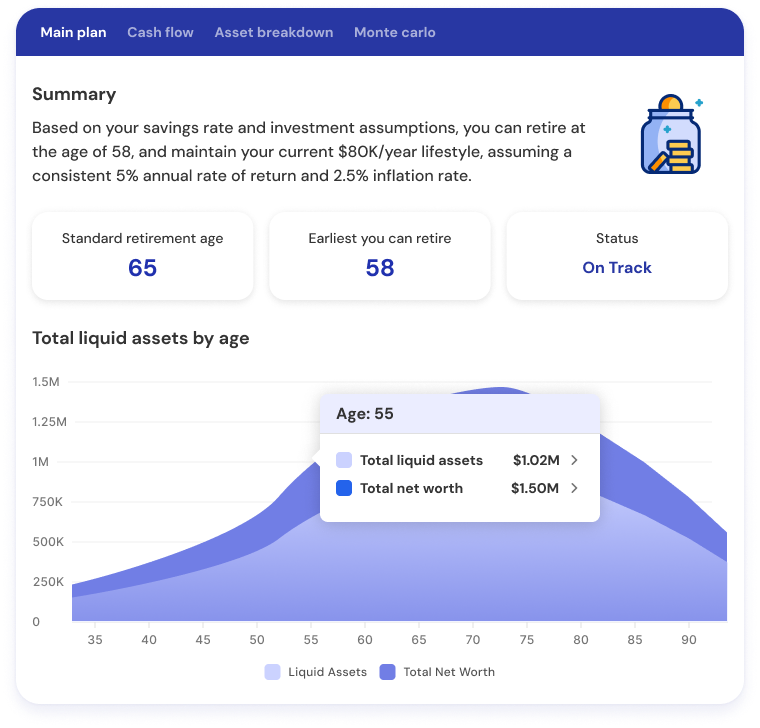Your 2025 Guide to 401(k) Catch-Up Contributions

What are 401(k) Catch-Up Contributions?
Retirement plan participants aged 50 and above can make higher than the standard contributions to 401K, IRAs and other types of tax advantaged retirement accounts to ensure that they save enough for their approaching retirement years. Catch up contributions can be made for both pre-tax accounts such as 401Ks and also post-tax accounts such as Roth IRAs.
Why are Catch Up Contributions Helpful?
- Overcome disadvantages of not being able to save in early career years: People whose income was lower in the early years of their careers, preventing them from putting aside adequate money in tax advantaged accounts, can use catch up contributions to save more from age 50.
- Recover from financial setbacks: People who suffered market losses or other financial setbacks that depleted their savings can benefit from catch up contributions.
- Prioritization of other goals such as kids’ education or home buying may have prevented adequate retirement savings.
- Debt payment earlier in one’s career (student loans,credit card debt, etc) may also have precluded savings for retirement. If you’re looking for extra ways to free up funds for retirement, you could explore 5 Overlooked Workplace Benefits To Save Money.
What Types of Retirement Accounts are Eligible for Catch Up Contributions?
The following type of plans allow catch up contributions:
- 401K, 403(b), eligible 457 plan, or government thrift savings plan: $7500 in catch up contributions
- IRA: $1000 in catch up contributions.
- Simple IRA or 401K: $3500 in catch up contributions.
401K Catch Up Contributions
The catch-up contributions for 401Ks for employees 50 and above are $7500. When you add the regular annual contributions of $23,500, the maximum that can be contributed by employees of 50 and above is $31,000.
IRA Catch Up Contributions in 2025
The catch up contributions for IRA can get the total annual IRA contributions to $8000.
Secure 2.0 Act Provisions That Matter
The Secure2.0 Act was enacted in 2022 to increase retirement savings and has several provisions directed towards helping older workers accelerate savings for retirement.
Key Provisions that impact Catch Up contributions and Older Workers
- For employees aged 60, 61, 62, 63, the catch up contribution is $11,250 instead of $7500 in 2025. This is based on changes made in Secure 2.0, which allows higher catch up contributions for employees 60, 61, 62 and 63.
- For SIMPLE IRAs the catch-up contribution limit is $3500 but for those from age 60, 61, 62 and 63 it is $5250.
- If you are 50+ and earning $145k or more, then the catch up contributions would have to be in a Roth 401K rather than regular 401K. Therefore you will not get tax benefits on a pre-tax basis but you can withdraw funds tax-free after retirement. If you’re interested in further Roth strategies, see What is the Backdoor Roth IRA Process?.
- Employer + employee contributions: The employer + employee contributions in 2025 have been increased to $70,000 from $69,000 in 2024.
- RMD 75: The age for taking required minimum distributions (RMDs) was raised from 72 to 73 under Secure 2.0. In 2033 it will rise to 75. The penalty for not taking distributions decreases from 50% to 25%, as of 2023.
- Education 529 implications and relief: In 2024, Secure 2.0 allowed people who have put money in 529s to roll over funds into a Roth IRA for the beneficiary, not exceeding the maximum Roth annual contributions, which also helps those looking to save for college.
- Emergency withdrawals without penalty: In general, people have to pay a penalty of 10% for 401K withdrawals prematurely. However, as of 2024, Secure 2.0 allows people to withdraw up to $1000 per year with an option to repay the money in a 3-year period for certain emergencies. If you do not repay it, you will not be allowed to withdraw more emergency distributions during the 3-year repayment period.
Other Secure 2.0 Provisions
Automatic 401K enrollment: eligible new employees and existing employees who are not already participating will be automatically enrolled in the employer’s 401K plans. The initial contribution will be at least 3% of pre=tax earnings but not more than 10%. The initial contribution will increase by 1% annually up to a ceiling of 10% or 15%. Employees who do not wish to participate in retirement plans will need to opt out.
References: From IRS website https://www.irs.gov/newsroom/401k-limit-increases-to-23500-for-2025-ira-limit-remains-7000
Tactics to Strengthen Your 401(k) Beyond 50
Prioritize maxing out all your retirement contributions
Workers over 50 who missed out on saving early in their careers may be worried about retirement. However, by taking advantage of the standard and catch up contribution provisions, it is possible to accumulate a significant nest egg by the age of 65. To enhance your portfolio, you might adopt a two-fund investment strategy that keeps investing simple yet effective.
Let us look at an example.
- If you are a 50 year old who is able to save $23,500 plus an additional catch up for $7500 every year from until age 65, you could accumulate $770,000 at retirement at age 65. Not too bad for a late career effort!
- This also has the added benefit of reducing your taxable income and paying lower taxes, thereby boosting your other savings as well.
Prioritize retirement savings over age 50
For many people at this stage, they may have kids ready for college or may wish to buy a bigger home or splurge more. However, given that you are now inching closer to retirement, it is important to prioritize retirement savings, including catch up contributions first, and then allocate money to other financial goals.
Conclusion: Final Thoughts on Securing your Retirement
Older workers can use catch up contributions to sock away more money in tax advantaged accounts and position themselves well for retirement. The catch up contribution limits for 2025 allow workers to save an additional $7500 for 401Ks, 403(b) and 457s, and additional $1000 in IRAs and $3500 in Simple 401Ks and SIMPLE IRAs. Moreover workers from age 60 to 63 have an additional option to save $11,250 instead of $7500 in catch up contributions. The Secure 2.0 Act of 2022 has further provisions that increase the age to start taking Required Minimum Distributions from age 72 to 73 and reduce the penalty for not taking distributions from 50% to 25%.
Planwell can help you plan for retirement, kids college and other financial goals with our fully automated financial planning tool. If you work in healthcare, check out these financial planning strategies for doctors & medical professionals to maximize your catch-up contributions and other retirement benefits.
- What is Coast FIRE? Find out how to Coast Your Way to Financial Independence.
- What is barista FIRE? Retire early and work part-time.
- Lean FIRE: The frugal way to achieve financial independence and retire early.
- How to retire early and achieve financial independence: Tips to retire early and achieve FIRE (Financial Independence, Retire Early)
- How to build a personal financial plan: Before you make a home purchase, make sure to build your personalized financial plan with our 10 step guide.
- How to Use AI Budget Calculators and Tools to Plan Your Finances: Take advantage of our free FIRE calculator to plan your finances more effectively.
- 5 Common Money Mistakes to Avoid: Learn about the pitfalls that could derail your early retirement plans.
Related Posts
About
©2023 Planwell.io


